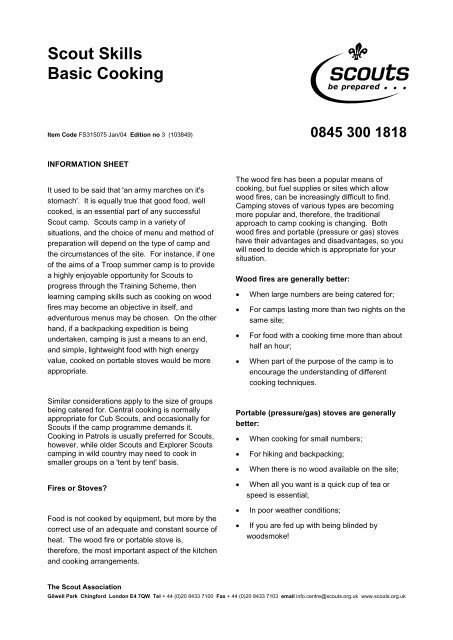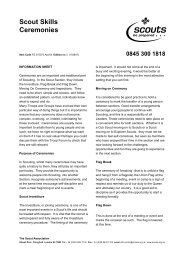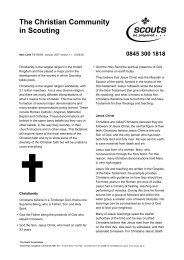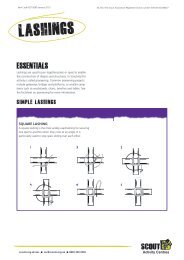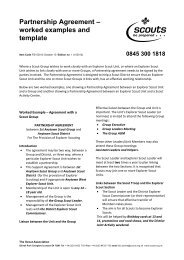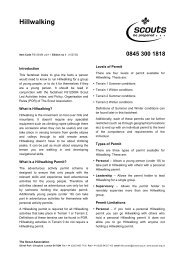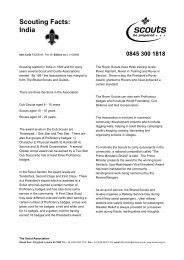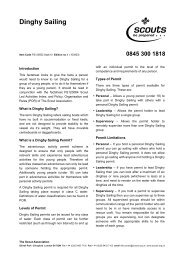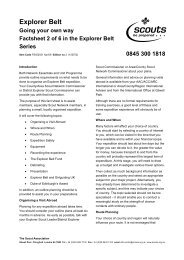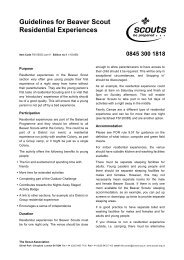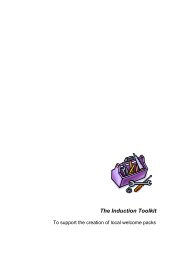FS315075 - Scout Skills - Basic Cooking - ScoutBase UK
FS315075 - Scout Skills - Basic Cooking - ScoutBase UK
FS315075 - Scout Skills - Basic Cooking - ScoutBase UK
- No tags were found...
You also want an ePaper? Increase the reach of your titles
YUMPU automatically turns print PDFs into web optimized ePapers that Google loves.
<strong>Scout</strong> <strong>Skills</strong><br />
<strong>Basic</strong> <strong>Cooking</strong><br />
S<br />
Item Code <strong>FS315075</strong> Jan/04 Edition no 3 (103849) 0845 300 1818<br />
INFORMATION SHEET<br />
It used to be said that 'an army marches on it's<br />
stomach'. It is equally true that good food, well<br />
cooked, is an essential part of any successful<br />
<strong>Scout</strong> camp. <strong>Scout</strong>s camp in a variety of<br />
situations, and the choice of menu and method of<br />
preparation will depend on the type of camp and<br />
the circumstances of the site. For instance, if one<br />
of the aims of a Troop summer camp is to provide<br />
a highly enjoyable opportunity for <strong>Scout</strong>s to<br />
progress through the Training Scheme, then<br />
learning camping skills such as cooking on wood<br />
fires may become an objective in itself, and<br />
adventurous menus may be chosen. On the other<br />
hand, if a backpacking expedition is being<br />
undertaken, camping is just a means to an end,<br />
and simple, lightweight food with high energy<br />
value, cooked on portable stoves would be more<br />
appropriate.<br />
Similar considerations apply to the size of groups<br />
being catered for. Central cooking is normally<br />
appropriate for Cub <strong>Scout</strong>s, and occasionally for<br />
<strong>Scout</strong>s if the camp programme demands it.<br />
<strong>Cooking</strong> in Patrols is usually preferred for <strong>Scout</strong>s,<br />
however, while older <strong>Scout</strong>s and Explorer <strong>Scout</strong>s<br />
camping in wild country may need to cook in<br />
smaller groups on a 'tent by tent' basis.<br />
The wood fire has been a popular means of<br />
cooking, but fuel supplies or sites which allow<br />
wood fires, can be increasingly difficult to find.<br />
Camping stoves of various types are becoming<br />
more popular and, therefore, the traditional<br />
approach to camp cooking is changing. Both<br />
wood fires and portable (pressure or gas) stoves<br />
have their advantages and disadvantages, so you<br />
will need to decide which is appropriate for your<br />
situation.<br />
Wood fires are generally better:<br />
<br />
<br />
<br />
<br />
When large numbers are being catered for;<br />
For camps lasting more than two nights on the<br />
same site;<br />
For food with a cooking time more than about<br />
half an hour;<br />
When part of the purpose of the camp is to<br />
encourage the understanding of different<br />
cooking techniques.<br />
Portable (pressure/gas) stoves are generally<br />
better:<br />
<br />
<br />
<br />
When cooking for small numbers;<br />
For hiking and backpacking;<br />
When there is no wood available on the site;<br />
Fires or Stoves<br />
Food is not cooked by equipment, but more by the<br />
correct use of an adequate and constant source of<br />
heat. The wood fire or portable stove is,<br />
therefore, the most important aspect of the kitchen<br />
and cooking arrangements.<br />
<br />
<br />
<br />
When all you want is a quick cup of tea or<br />
speed is essential;<br />
In poor weather conditions;<br />
If you are fed up with being blinded by<br />
woodsmoke!<br />
The <strong>Scout</strong> Association<br />
Gilwell Park Chingford London E4 7QW Tel + 44 (0)20 8433 7100 Fax + 44 (0)20 8433 7103 email info.centre@scouts.org.uk www.scouts.org.uk
page 2 of 8<br />
<strong>Cooking</strong> Methods<br />
Everyone would soon get fed up if they had to eat<br />
the same food cooked the same way every day,<br />
but most foods can be satisfactorily cooked in a<br />
number of different ways, each with its own end<br />
result in terms of taste and texture. <strong>Cooking</strong> times<br />
vary, however (always check with a recipe if you<br />
are unsure of how long to cook something for).<br />
When using a variety of methods, take care to<br />
check that not only is the food well cooked (that is,<br />
not still raw!), but that all parts of the dish are<br />
ready to be served at the same time.<br />
Many foods benefit from the addition of herbs or<br />
sauces, and you should not be afraid to use them<br />
just because you are at camp. Most sauces are<br />
readily available in dried form, packed in sachets<br />
and usually have simple cooking instructions<br />
printed on the back - so there is little excuse for<br />
bland, tasteless food to be served at camp.<br />
Here are some of the different methods or cooking<br />
techniques which can be used:<br />
Boiling - <strong>Cooking</strong> in water ('It's boiling when it's<br />
bubbling'!). This is the simplest and most<br />
common method of cooking and, providing you<br />
don't boil the pot dry, the method least likely to go<br />
wrong! This method may be used for most<br />
vegetables, rice and pasta, and cooking periods<br />
range from about 10 minutes from the time the<br />
water comes to the boil for green vegetables, to<br />
30 minutes for the harder root vegetables such as<br />
carrots. Root vegetables should be placed in the<br />
water and brought to the boil from cold; greens<br />
are best put into the water once it has boiled. All<br />
vegetables should be cooked with the pot lids on,<br />
but pasta is boiled without a lid. Take care not to<br />
overcooks as all foods tend to lose colour, taste,<br />
texture and nutritional value if boiled for too long.<br />
Stewing - <strong>Cooking</strong> in water below boiling point.<br />
This is the term used for bringing food to boiling<br />
point, and then simmering it at a temperature just<br />
below boiling point without letting it bubble<br />
furiously. An old saying 'a stew boiled is a stew<br />
spoiled' sums it up very well! It is normally used<br />
as a means of cooking meat or fruit. In the case<br />
of meat, at least an hour is required after the liquid<br />
comes to the boil. Root vegetables are normally<br />
included in a meat stew, but the softer ones, such<br />
as potatoes must be added part way through the<br />
cooking to avoid overcooking them and reducing<br />
them to pulp. Meat stews need the addition of<br />
stock cubes, and there is also a wide range of<br />
powdered sauce mixes which, as previously<br />
mentioned, can make a great difference. Sugar<br />
has to be added to all stewed fruit. For any stew,<br />
long simmering times require good fire<br />
management.<br />
Frying - <strong>Cooking</strong> over heat with a film of fat<br />
covering the bottom of the pan. This is often<br />
assumed to be the most common method of<br />
cooking at camp: in fact it is the most difficult<br />
cooking method to do well. The main problem is<br />
maintaining a moderate heat source over a large<br />
enough cooking area to allow more than two or<br />
three people to be served together. A fire can<br />
provide a large enough cooking area, but it can be<br />
difficult to hold the critical temperature needed for<br />
more than a few minutes. Stoves have a flame<br />
that can be more readily controlled over a period<br />
of time, but burners are rarely large enough to<br />
cook in large quantities. Frying, and hence the<br />
use of fat, has had a bad press in recent years on<br />
health grounds, and is best used sparingly.<br />
Stir-frying - has the advantage of cooking all of the<br />
ingredients - meat and vegetables - in the same<br />
pan at the same time. Therefore it has<br />
considerable potential for camp use as it reduces<br />
the space required over fires, takes less time<br />
compared to other methods, and it can be<br />
prepared and served together. Care will,<br />
however, need to be taken to perhaps start certain<br />
ingredients before others such as meat before<br />
vegetables as their overall cooking time is<br />
different.<br />
Deep frying - <strong>Cooking</strong> the food by complete<br />
immersion in hot fat or oil is more difficult and can<br />
be dangerous in a camp situation, but can be
page 3 of 8<br />
done. This method may be used for cooking food<br />
such as fish and vegetables coated in batter or<br />
breadcrumbs.<br />
Baking - <strong>Cooking</strong> in an oven without covering and<br />
roasting or cooking in an oven with fat, are<br />
feasible in a camp oven constructed from a biscuit<br />
tin or similar metal box, encased in clay and fitted<br />
with a chimney (see below). This arrangement<br />
allows the heat from a fire burning in a trench<br />
underneath to completely surround the oven and<br />
give a very good result. No calibration is possible,<br />
however, and cooking times must be determined<br />
by trial and error! Baking can be used for most<br />
foods from pastry and bread to meat and<br />
vegetables. Potatoes can be baked by wrapping<br />
them in foil and placing them in the glowing<br />
embers which are left after the flames have died<br />
down in a fire. Roasting is used for meat and<br />
vegetables.<br />
Grilling - <strong>Cooking</strong> over or under a direct fierce<br />
heat. This method is appropriate for thin cuts of<br />
meat, fish, poultry or game, a few vegetables such<br />
as mushrooms, and tomatoes and bread (for<br />
toast). This is a relatively quick method of<br />
cooking which should not be left unattended and,<br />
indeed, food often needs 'turning' during cooking.<br />
A 'barbecue' works on this principle.<br />
Poaching - <strong>Cooking</strong> food in simmering water. The<br />
water is boiled and then kept simmering at just<br />
below boiling point. This method is suitable for<br />
eggs and fish. Eggs can be done individually by<br />
breaking them onto a plate or saucer and then<br />
sliding them into the simmering water. With the<br />
help of two spoons cover the yolks with the white<br />
of the eggs. The pan should then be covered and<br />
the eggs allowed to cook for five or six minutes.<br />
For fish, cover with lightly salted water and leave<br />
to simmer until it flakes easily when tested with a<br />
fork, allowing about 10 minutes for 500g of fish.<br />
Pot-roasting - Is a method of roasting a joint of<br />
meat, without an oven. An ideal container is a<br />
large billie, having a capacity of seven to eight<br />
litres and a diameter of about 20 cm. Hard root<br />
vegetables such as turnips, swedes, parsnips are<br />
cut into large pieces (onions are best left whole),<br />
packed tightly into the bottom of the billie to a<br />
depth of about IO cm, and just covered with water.<br />
The meat is then placed on top of the vegetables,<br />
standing clear of the liquid. The billie is brought to<br />
the boil and simmered with a lid on until the meat<br />
is tender - this normally takes about half an hour<br />
per pound, depending on the cut. The billie must<br />
be checked regularly during cooking to make sure<br />
it does not boil dry.<br />
Steaming - <strong>Cooking</strong> in the steam resulting from<br />
boiling water. This can be used for fish, poultry,<br />
vegetables or puddings. Steaming can be done<br />
by one of two methods: firstly by placing a small<br />
amount of water in a saucepan and by keeping it<br />
'on the boil', and with a tightly fitting lid, the<br />
resulting steam cooks the food or, secondly, by<br />
using a specifically designed 'steamer'. The<br />
timing varies considerably depending upon what<br />
is being cooked, for example, fillets or thin cuts of<br />
fish will take about 10- 1 5 minutes, a whole<br />
chicken, three to four hours, vegetables about five<br />
minutes longer than boiling them and puddings,<br />
take between two and three hours. For both<br />
methods, you need to check that they don't 'boil<br />
dry'.<br />
Braising - <strong>Cooking</strong> in an oven in a tightly closed<br />
container. This method, like pot-roasting, is a<br />
slow method and therefore requires more<br />
planning. It can be used for meat (smaller cuts of<br />
meat rather than a joint), fish, poultry, game and<br />
vegetables.
page 4 of 8<br />
Measuring quantities<br />
We take measuring ingredients at home for<br />
granted as we have the equipment that will do the<br />
job! However, at camp, we may be limited in what<br />
equipment is available. Here are a few hints on<br />
what can be used: 25g (I oz.) flour, cocoa, custard<br />
powder = a well-heaped tablespoon.<br />
25g (1 oz.) sugar, rice, butter, fat = a level<br />
tablespoon.<br />
250ml (half a pint) liquid = a normal camp mug<br />
full.<br />
It is also possible to use a 'camp mug' for<br />
measuring all sorts of things. For example, when<br />
lightly filled, it will hold the following approximate<br />
weights:<br />
125g (5 oz.)<br />
200g (8 oz.)<br />
100g (4 oz.)<br />
175g (7 oz.)<br />
150g (6 oz.)<br />
flour<br />
sugar<br />
grated cheese<br />
rice<br />
dried fruit<br />
Wherever possible, of course, ingredients can be<br />
prepared or weighed at home before leaving for<br />
camp, or other containers can be checked for how<br />
much they hold.<br />
Tricks of the trade<br />
<br />
<br />
<br />
<br />
<br />
<br />
<br />
<br />
<br />
<br />
<br />
<br />
If you are using a portable stove, make sure<br />
that you have enough fuel before you start<br />
cooking;<br />
If you are using a wood fire, ensure that the<br />
grid will take the weight of the utensils safely;<br />
If you are using a wood fire, make sure that<br />
you light it in plenty of time - it's not like<br />
switching on an oven!<br />
The best cooking fires are not only smokeless<br />
but also virtually flameless. A good bed of hot<br />
ashes gives a constant heat - and constant<br />
heat is a secret of good cooking.<br />
If you are using a wood fire, coat the outside<br />
of cooking utensils with detergent before<br />
using - it makes them much easier to clean<br />
afterwards;<br />
Keep a container of hot water on the fire or<br />
stove whenever you are working in the camp<br />
kitchen - you will always have an instant<br />
supply for washing-up water and cups of tea;<br />
Always stoke up the fire under the washing-up<br />
water before you sit down to eat;<br />
Do not attempt to lift heavy containers of<br />
boiling water - to transfer water, use a jug or<br />
ladle to avoid scalds;<br />
Handles of cooking utensils can become very<br />
hot - use oven gloves or pads to avoid burns;<br />
Serve your food in an attractive and<br />
appetising way, even something which tastes<br />
'perfect' can be off-putting if not presented<br />
well;<br />
Keep the kitchen area tidy if you want to be<br />
able to find everything when you want it;<br />
Burn or bin food scraps immediately after<br />
every meal;<br />
<br />
<br />
<br />
<br />
Always wash your hands before handling<br />
food;<br />
Keep the insides of cooking utensils<br />
scrupulously clean;<br />
If you use frozen food, ensure that it is<br />
completely thawed before use;<br />
If frying on a wood fire, use I a covered frying<br />
pan, or splatter guard;<br />
<br />
<br />
<br />
When removed, lids of cooking utensils<br />
should always be put down rim uppermost;<br />
Serving spoons, ladles and other implements<br />
should be put on a plate - never on the<br />
ground;<br />
Finally, remember, 'too many cooks spoil the<br />
broth'!
page 5 of 8<br />
Further information and resources<br />
TEACH YOURSELF<br />
Talk with other Leaders who have experience of<br />
catering (menus, quantities, techniques and so<br />
on) in camp situations. Perhaps there is a<br />
Quartermaster who can give you some hints and<br />
tips on what equipment is currently available and<br />
on its use.<br />
There are various books available:<br />
Nights Away , a comprehensive guide for<br />
adults to camping, holidays, expeditions, and<br />
sleepovers includes a Chapter on Catering. It<br />
provides you with sample menus, explains<br />
how to set up a kitchen, and tells you all you<br />
need to know about hygiene, storage,<br />
estimating quantities, cooking methods, and<br />
waste disposal.<br />
The <strong>Scout</strong> Matrix also includes a section on<br />
firelighting and cooking in the Activities and<br />
<strong>Skills</strong> chapter.<br />
Back to <strong>Basic</strong>s (available from the Information<br />
Centre at Gilwell Park) covers various aspects of<br />
cooking at camp; Fire Lighting in this series<br />
outlines the different types of fire that can be used<br />
for cooking; conventional cooking books will<br />
obviously offer many suggestions for different<br />
types and sizes of meals. Camping shops and<br />
other equipment suppliers may also have a<br />
selection of publications which give ideas<br />
specifically for camp menus.<br />
Have a look at the activity badge requirements<br />
for Camp Cook, and Chef, and the Outdoor,<br />
Outdoor Plus, and Expedition Challenges (in<br />
“Troop Essentials” to see how cooking skills<br />
can be included in the Troop’s balanced<br />
programme.<br />
Time<br />
This will vary depending upon what you choose to<br />
cook and how many of the cooking techniques are<br />
chosen to practise at any one time. However, as<br />
a guide, it is probably not practical to undertake a<br />
meal including several techniques in less than two<br />
or three hours. Individual techniques may take<br />
anything from five minutes to three hours!<br />
Equipment<br />
Wood supply and/or portable stove, cooking<br />
utensils, cleaning materials, clock or timer and<br />
food as per your choice of meal(s).<br />
Learning all about it<br />
Details of the techniques used for cooking are<br />
contained in the Information Sheet and you will<br />
need to have read this before proceeding. There<br />
is really only one method to learn about basic<br />
cooking techniques and that is, of course, to do it!<br />
This could be done all in one go, but is probably<br />
best done over a series of evenings or sessions to<br />
benefit from being able to properly sample the<br />
results! If there is an opportunity to practise in a<br />
camp situation, this is better still.<br />
<strong>Cooking</strong> techniques that might be covered<br />
include:<br />
boiling stewing frying<br />
stir-frying baking roasting<br />
pot-roasting grilling poaching<br />
steaming<br />
braising<br />
Decide on whether you are going to prepare a<br />
series of complete meals or just individual dishes.
page 6 of 8<br />
Plan your menu and check that by cooking them<br />
all you will have covered all the different cooking<br />
techniques that you want to try out. It is possible<br />
to design a meal which allows for the different<br />
foods to be prepared by each of the techniques,<br />
for example boiling (green vegetables), stewing<br />
(meat casserole), frying (mushrooms), roasting<br />
(potatoes) and so on. But be warned, this may<br />
not result in the most economical or 'well timed'<br />
meal!<br />
If your experience of these cooking techniques is<br />
limited, try them out at home or at a <strong>Scout</strong><br />
Headquarters first, before over a fire or at a camp<br />
where hungry mouths are anxiously awaiting the<br />
results!<br />
Boiling<br />
Stewing<br />
Frying<br />
stir-frying<br />
baking<br />
roasting<br />
pot-roasting<br />
grilling<br />
poaching<br />
steaming<br />
braising<br />
<br />
<br />
<br />
<br />
<br />
<br />
<br />
<br />
<br />
<br />
<br />
Offer to work alongside and help out an<br />
experienced caterer at a camp or event. There is<br />
no better way of finding out about the shortcuts<br />
and pitfalls of preparing food.<br />
Taking an egg, tomato or a potato, use as many<br />
of the cooking techniques as possible for each or<br />
all of these items.<br />
When you feel happy about the different<br />
techniques and when they should be used, try<br />
them out using different types of fire or stove and<br />
decide on the best type of heat source to use for<br />
each technique.<br />
So you want more<br />
Have a go at making and constructing different<br />
types of wood fires and cooking a variety of foods<br />
on them. Which were the most successful and<br />
why<br />
Try cooking without utensils, that is, cooking with<br />
aluminium foil and backwoods cookIng.<br />
Investigate and try out menus for expedition<br />
cooking. These are usually lightweight to carry,<br />
but high in calories or energy.<br />
HOW TO TRAIN OTHERS<br />
Can I do it<br />
When you feel confident about basic cooking and<br />
the various techniques, check how you are doing<br />
and see which of the following you can tick off:<br />
Can I list the advantages and disadvantages of<br />
wood fires and portable (pressure/gas) stoves <br />
Can I describe the different cooking techniques<br />
used for specific types of food<br />
Which of the following cooking techniques can I<br />
demonstrate<br />
<br />
This section is designed to give some practical<br />
ideas about how you can help other people to<br />
learn about basic cooking. They might be<br />
Leaders or <strong>Scout</strong>s - either in an informal way on a<br />
Troop night or more formally on a skills workshop,<br />
training course or something similar.<br />
Objectives<br />
By the end of this session, participants will be able<br />
to:<br />
I. State the advantages and disadvantages<br />
of wood fires and portable stoves;
page 7 of 8<br />
II.<br />
III.<br />
Select the best cooking method for a<br />
particular type of given food;<br />
Demonstrate six of the following different<br />
cooking techniques:<br />
You could use the following method, devise your<br />
own, or alternatively use the training activities<br />
without any prior information being given,<br />
depending of course upon the experience of the<br />
participants.<br />
boiling stewing frying<br />
stir-frying baking roasting<br />
pot-roasting grilling poaching<br />
steaming<br />
Time<br />
braising<br />
This will depend upon what activities are chosen<br />
and how many cooking techniques the<br />
participants undertake. However, as a guide, it is<br />
probably not practical to undertake a meal<br />
including several techniques in less than two or<br />
three hours. Individual techniques may take<br />
anything from five minutes to three hours!<br />
With participants in small groups, give them some<br />
means of cooking the food (a gas or pressure<br />
stove, materials for making a fire or access to a<br />
cooker), a menu, some food, a clock or timer, and<br />
ask them to prepare the meal for a given time.<br />
They will need to plan what needs to be done,<br />
share out the work and manage their time.<br />
Depending upon the experience in the group, you<br />
may like to give them a cookbook which outlines<br />
the cooking techniques or copy the details from<br />
the Information Sheet in this pack.<br />
One or more of the following training activities<br />
might then be undertaken to reinforce the learning<br />
or to check the participants understanding of basic<br />
cooking.<br />
Equipment<br />
Training activities<br />
Wood supply and/or portable stove, cooking<br />
utensils, cleaning materials, clock or timer, food<br />
as per choice of meal(s) and any other items<br />
specified for the training activities.<br />
Training method<br />
Circuit cooking - Set up a series of bases which<br />
requires the participants to visit the bases and<br />
undertake a task such as boiling an egg, poaching<br />
a kipper and so on. These tasks can be as simple<br />
or as elaborate as you like. Alternatively, this<br />
principle could be used to demonstrate basic<br />
cooking techniques before participants have a go.<br />
For participants to learn about the different<br />
cooking techniques that are available to them, the<br />
only real method is for them to have a go! It may<br />
be useful for there to be some demonstration for<br />
the more unusual techniques and if participants<br />
are working in small groups, try to ensure that<br />
there is one member of the group who has some<br />
experience. An ideal place for participants to<br />
practice would be in a camp situation. However,<br />
for a first attempt, a <strong>Scout</strong> Headquarters, Troop<br />
room, or any other facilities with a kitchen may be<br />
more helpful.<br />
<strong>Cooking</strong> competition - Arrange a competition for<br />
small groups of participants (or Patrols) who have<br />
to plan and prepare a menu in competition against<br />
other groups. The choice of menu and food can<br />
be left to the groups, or food and techniques can<br />
be specified.<br />
Menu planning - With participants working as<br />
individuals or in pairs, ask them to plan a<br />
balanced menu for a camp or event. The results<br />
should then be discussed and justified with<br />
another individual or pair.
page 8 of 8<br />
Camp ovens - With participants in small groups,<br />
supply them with the necessary materials and ask<br />
them to build a camp oven and use it.<br />
International cooking - Ask each group of<br />
participants to try out a menu or meal from<br />
another country and link it with an international<br />
evening. This again, could be the choice of the<br />
group or be specified to ensure a balance of<br />
different menus.<br />
So they want to know more<br />
Build different types of wood fires and try out<br />
different cooking techniques. Which are the most<br />
successful<br />
Investigate more 'elaborate methods and<br />
techniques of cooking. Try them out by planning<br />
and preparing a three course meal for guests.<br />
'Cooks challenge' - With participants in pairs, give<br />
each pair eggs, tomatoes, or potatoes and<br />
challenge them to prepare them using as many<br />
different cooking techniques as possible.<br />
Try cooking without utensils, that is, 'backwoods<br />
cooking'. Again, try and prepare a three course<br />
meal.<br />
Pancake party - With participants in small groups,<br />
give each group 2 eggs, 100g plain flour, 250ml<br />
milk, pinch of salt, lard or fat for frying, spoon and<br />
spatula, frying pan, a pressure or gas stove (or<br />
other source of heat), and anything else you wish<br />
to add for variations.<br />
Challenge participants to: make coloured<br />
pancakes, hold a pancake race (perhaps over an<br />
obstacle course), make the largest pancake (not<br />
the thickest!), or hold a pancake tossing<br />
competition.<br />
Checking their progress<br />
Ask participants if they can answer the following<br />
questions:<br />
1) Can I explain the advantages and<br />
disadvantages of wood fires and portable<br />
stoves<br />
2) Can I select the best cooking method for a<br />
particular type of food<br />
3) Can I show how to do six of the following<br />
different cooking techniques<br />
Boiling Stewing Frying<br />
Stir-frying Baking Roasting<br />
Pot-roasting Grilling Poaching<br />
Steaming<br />
Braising


